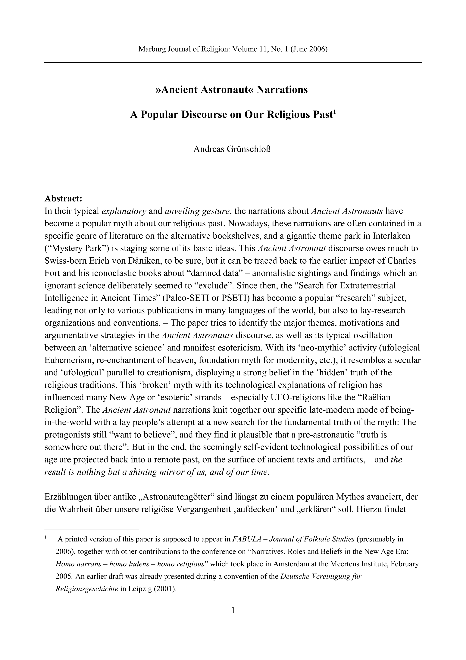»Ancient Astronaut« Narrations. A Popular Discourse on Our Religious Past
In their typical explanatory and unveiling gesture, the narrations about Ancient Astronauts have become a popular myth about our religious past. Nowadays, these narrations are often contained in a specific genre of literature on the alternative bookshelves, and a gigantic theme park in Interlaken (“...
Gespeichert in:
| Veröffentlicht in: | Marburg Journal of Religion |
|---|---|
| 1. Verfasser: | |
| Format: | Artikel (Zeitschrift) |
| Sprache: | Deutsch |
| Veröffentlicht: |
Philipps-Universität Marburg
2007
|
| Online Zugang: | Online Zugang |
| Tags: |
Tag hinzufügen
Keine Tags, Fügen Sie den ersten Tag hinzu!
|
| Zusammenfassung: | In their typical explanatory and unveiling gesture, the narrations about Ancient Astronauts have become a popular myth about our religious past. Nowadays, these narrations are often contained in a specific genre of literature on the alternative bookshelves, and a gigantic theme park in Interlaken (“Mystery Park”) is staging some of its basic ideas. This Ancient Astronaut discourse owes much to Swiss-born Erich von Däniken, to be sure, but it can be traced back to the earlier impact of Charles Fort and his iconoclastic books about “damned data” – anomalistic sightings and findings which an ignorant science deliberately seemed to “exclude”. Since then, the “Search for Extraterrestrial Intelligence in Ancient Times” (Paleo-SETI or PSETI) has become a popular “research” subject, leading not only to various publications in many languages of the world, but also to lay-research organizations and conventions. – The paper tries to identify the major themes, motivations and argumentative strategies in the Ancient Astronauts discourse, as well as its typical oscillation between an ‘alternative science’ and manifest esotericism. With its ‘neo-mythic’ activity (ufological Euhemerism, re-enchantment of heaven, foundation myth for modernity, etc.), it resembles a secular and ‘ufological’ parallel to creationism, displaying a strong belief in the ‘hidden’ truth of the religious traditions. This ‘broken’ myth with its technological explanations of religion has influenced many New Age or ‘esoteric’ strands – especially UFO-religions like the “Raëlian Religion”. The Ancient Astronaut narrations knit together our specific late-modern mode of beingin-the-world with a lay people’s attempt at a new search for the fundamental truth of the myth: The protagonists still “want to believe”, and they find it plausible that a pre-astronautic “truth is somewhere out there”: But in the end, the seemingly self-evident technological possibilities of our age are projected back into a remote past, on the surface of ancient texts and artifacts, – and the result is nothing but a shining mirror of us, and of our time. |
|---|---|
| DOI: | 10.17192/mjr.2007.11.3617 |
 Publikationsserver
Publikationsserver